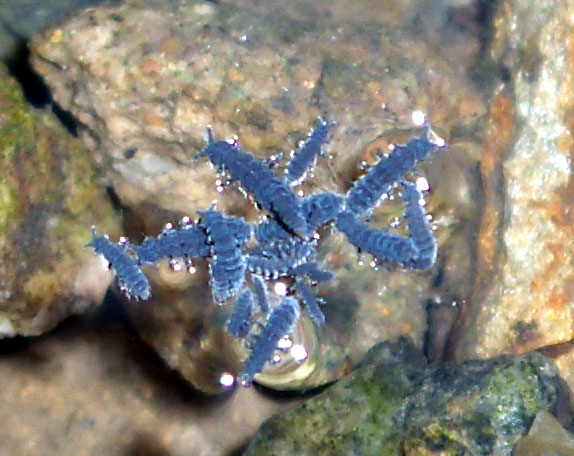- Anurida maritima
Taxobox | name = "Anurida maritima"

image_width = 240px
image_caption = An aggregation of "A. maritima" on the surface of a rock-pool
regnum =Animal ia
phylum =Arthropod a
classis = Collembola
ordo =Poduromorpha
familia =Neanuridae
genus = "Anurida "
species = "A. maritima"
binomial = "Anurida maritima"
binomial_authority = (Guérin-Méneville, 1836) [ITIS|ID=100182|taxon="Anurida maritima"]
synonyms = "Lipura maritima" (Guérin-Méneville, 1836) [cite web |url=http://www.soortenbank.nl/soorten.php?soortengroep=duikgids&menuentry=soorten&id=74&tab=synoniemen |title=Blauwe springstaart ("Anurida maritima"): wetenschappelijke synoniemen en populaire namen |publisher=SoortenBank.nl |accessdate=2007-10-02 nl icon]"Anurida maritima" is a cosmopolitan collembolan of the
intertidal zone . It is often found in aggregations of up to several hundred on the surface of rock-pools.Description
"A. maritima" is a wingless animal, typically up to 3 mm long, and dark slaty blue in colour cite web |url=http://www.marlin.ac.uk/species/Anuridamaritima.htm |title=A springtail - "Anurida maritima" |date=
2007-08-08 |author=Sonia Rowley |work=Marine Life Information Network for Britain and Ireland |publisher=Marine Biological Association of the United Kingdom ] . Its body is roundish, expanding slightly towards the rear. Thehead bears a pair ofeye s and a single pair of antennae, thethorax comprises threebody segment s, each of which bears one pair of legs, while theabdomen comprises six segments . The entire body is covered with white hydrophobic hairs which allow the animal to stay above the surface of the water on which it spends much of its life. Like many other springtails, "A. maritima" cannot leap, since its furcula is vestigial .Distribution and ecology
"A. maritima" is found around the world on
rocky shore s andtidal marsh es. In the British Isles, it is missing from the north-east ofScotland and has not been recorded from south-east Ireland. It is also absent from theBaltic Sea . There have been suggestions that the animals found in northern Europe may be a different species from that found in theMediterranean Sea cite web |url=http://www.stevehopkin.co.uk/collembolamaps/Poduromorpha/068ANmar/ |title="Anurida maritima" |work=The Natural World in Close Up |author=Steve Hopkin] .In the warmer parts of its range, "A. maritima" is active throughout the year, but in cooler
temperate regions, it is only active in the summer months,overwinter ing as eggs [cite journal |quotes=no |author=Els N. G. Joosse |title=Some observations on the biology on "Anurida maritima" (Guérin), (Collembola) |journal=Zeitschrift für Morphologie und Ökologie der Tiere |volume=57 |issue=3 |pages=320–328 |year=1966 |doi=10.1007/BF00407599] .Ecology
"A. maritima" is a significant
scavenger of the upper intertidal zone, feeding on dead animals, chieflycrustacean s (includingbarnacle s) and molluscs .Aggregation is an important aspect of collembolan biology, and "A. maritima" has been shown to produce an aggregating
pheromone cite journal |quotes=no |author=Andrea Manica, Fiona K. McMeechan & William A. Foster |year=2001 |title=An aggregation pheromone in the intertidal collembolan "Anurida maritima" |journal=Entomologia Experimentalis et Applicata |volume=99 |issue=3 |pages=393–395 |doi=10.1046/j.1570-7458.2001.00840.x] . Like many intertidal animals, "A. maritima" moves in rhythm with thetidal cycle , and has anendogenous circatidal rhythm with a period of 12.4 hours , using visual cues to orientate themselves during their movements cite journal |quotes=no |author=Andrea Manica, Fiona K. McMeechan & William A. Foster |year=2000 |title=Orientation in the intertidal salt-marsh collembolan "Anurida maritima" |journal=Behavioral Ecology and Sociobiology |volume=47 |issue=6 |pages=371–375 |doi=10.1007/s002650050679] .References
Wikimedia Foundation. 2010.
